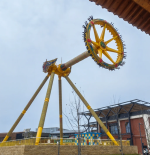Today’s thrill rides are more than just fast and tall—they’re getting smarter. With sensors, automation, and AI, rides are now safer, smoother, and easier to run.
Sensor-Based Adaptive Control Systems
Modern rides use sensors to track things like wind, weight, and temperature. The system adjusts power and braking in real time to keep the ride stable.
For pendulum rides, it monitors swing angles and motor force. If it finds stress or wear, it changes the ride cycle or alerts for maintenance—helping avoid breakdowns and extend ride life.
AI-Assisted Safety Protocols
Traditional safety protocols rely on operator vigilance and mechanical redundancy. Today’s intelligent rides augment this with predictive maintenance and AI-assisted diagnostics. These systems track thousands of ride cycles, comparing performance metrics against baseline conditions. When patterns of micro-deviation emerge—such as slightly delayed deceleration or excessive vibration—automated flags are raised before mechanical issues become visible.
AI also supports crowd management by integrating with park management systems. It predicts wait times, adjusts queue pacing, and even triggers alerts when rider behavior suggests discomfort or irregularities. This level of foresight represents a critical evolution in safety management for high-stimulation attractions.
Immersive Augmentation and Theming
Beyond mechanics, intelligence is enhancing the psychological dimension of thrill. LED mapping, synchronized lighting, surround audio, and projection systems work in tandem with the ride’s physical motion. Riders are not just dropped, swung, or spun—they are immersed in narrative environments where motion is part of the story arc.
One standout implementation is seen in pendulum rides for sale, which now feature programmable ride sequences. Operators can create different profiles for different times of day or events—family-friendly swings in the afternoon, and extreme sequences after dark. These customizable modes increase re-ride value and allow operators to appeal to a broader demographic without investing in separate attractions.
Biometric and RFID-Based Personalization
Personalized rides enhance guest experience using biometric sensors like heart rate monitors and pressure-sensitive seats. These allow real-time adjustments to ride intensity based on each rider’s profile.
RFID wristbands and apps let guests save settings, track ride history, and unlock badges or souvenirs—turning each ride into a unique memory.
Energy Efficiency Through Intelligent Drives
Modern rides use energy-saving systems like variable frequency drives (VFDs) and regenerative braking. VFDs adjust power based on demand, while regenerative systems reuse braking energy, cutting operating costs and supporting eco-friendly goals.
Dynamic Queue and Load Management
Smart queue systems and load-balancing tech optimize ride efficiency. Algorithms control how many seats to run based on traffic. Features like facial recognition and digital tickets speed up boarding and reduce idle time.
Integration of Real-Time Ride Analytics
Operators can now monitor rides in real time, tracking data like cycle count, stress levels, and conditions remotely. Riders also get post-ride stats—such as G-forces or selfies—boosting engagement and shareability.
Enhanced Thematic Synchronization
Intelligent control units are also being used to synchronize thematic elements. Lighting, music, wind effects, fog, and animatronics all respond dynamically to ride movement, rather than following pre-scripted loops. This makes each ride slightly different—even on repeat rides—adding variability that keeps the experience fresh.
Consider a pirate ship amusement ride enhanced with synchronized wave simulations and storm soundscapes. As the ship reaches peak swing, simulated lightning cracks across the backdrop while onboard lighting flickers in time with thunder. These effects extend immersion far beyond what mechanical motion alone can provide.
Predictive Lifespan Modeling
Intelligent systems don’t just track the present—they anticipate the future. Advanced modeling software now allows operators to estimate component lifespans based on real usage patterns. Bearings, brakes, belts, and motors are monitored through wear indicators and temperature trends, enabling targeted part replacement before breakdowns occur.
This predictive capability transforms maintenance from reactive to proactive. Scheduled interventions are more efficient, and long-term costs are lowered. Moreover, data-informed lifespan modeling supports better capital planning for ride refurbishments and upgrades.
Conclusion: Intelligence as the New Thrill Frontier
As technology redefines the limits of ride design, stimulation is no longer restricted to physical parameters. Through smart systems, adaptive responses, and immersive personalization, thrill rides are evolving into intelligent experiences. Whether it’s optimizing a pendulum’s swing or turning a pirate ship into a storm-ridden voyage, the fusion of mechanics and intelligence is creating attractions that thrill the body, engage the mind, and adapt to each guest in real time.
Intelligent trends are not just enhancing rides—they are transforming them into dynamic, responsive ecosystems that ensure every visit feels like a first.

